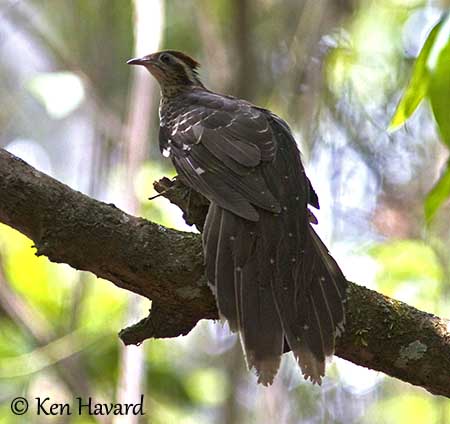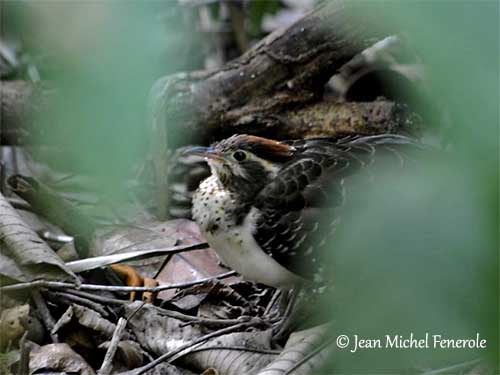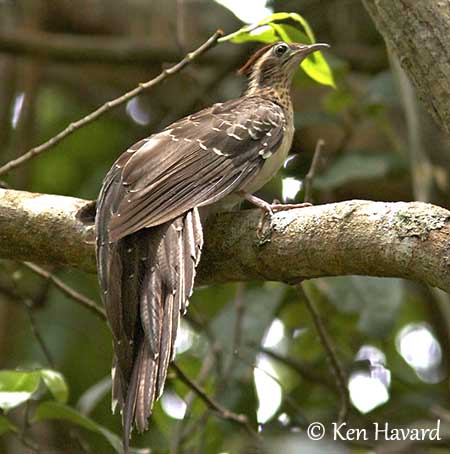
Fr: Géocoucou faisan
Ang: Pheasant Cuckoo
All: Fasanenkuckuck
Esp: Cuclillo Faisán
Ita: Cuculo corridore fagiano
Nd: Fazantkoekoek
Sd: Fasangök
Port: Peixe-frito-verdadeiro
Photographers:
Jean Michel Fenerole
Photos d’Oiseaux du monde
Ken Havard
My Bird Gallery & Flickr gallery 1 & Flickr gallery 2
Text by Nicole Bouglouan
Sources :
HANDBOOK OF THE BIRDS OF THE WORLD vol 4 by Josep del Hoyo-Andrew Elliott-Jordi Sargatal - Lynx Edicions - ISBN: 8487334229
BirdLife International (BirdLife International)
Neotropical Birds – Cornell Lab of Ornithology
Wikipedia, the free encyclopaedia
PHEASANT CUCKOO FORAGING BEHAVIOR, WITH NOTES ON HABITS AND POSSIBLE SOCIAL ORGANIZATION IN PANAMA
pdf from ResearchGate
By KATHRYN E. SIEVING - Journal of Field Ornithology, 1990
Department of Ecology, Ethology and Evolution
University of Illinois
Shelford Vivarium
606 East Healey St.
Champaign, Illinois 61820 USA
Pheasant Cuckoo
Dromococcyx phasianellus
Cuculiformes Order – Cuculidae Family
INTRODUCTION:
The Pheasant Cuckoo is known to be a brood parasite included in the subfamily Neomorphinae of the New World ground cuckoos in the family Cuculidae.
This terrestrial species is usually found in tropical forests where it forages for large insects and small lizards taken from the ground. This long-legged and long-tailed cuckoo occurs in Central America and northern part of South America.
DESCRIPTION OF THE BIRD:
Biometrics:
Length: 36 cm with tail of 17,5 to 24,5 cm
Weight: 80-85 g
The adult has dark sooty brown upperparts. Scapulars and wing-coverts have pale-edged feathers involving scaled effect. The flight feathers are dark greyish-brown. Rump and uppertail-coverts are dark greyish-olive, with small white tips to uppertail-coverts. The long, graduated tail is dark greyish-brown with narrow white terminal band.
The underparts are white, but the breast is mostly whitish-buff with dark brown streaks and spots. Axillaries and underwing-coverts are white, but the flight feathers and the tail are greyish-brown.
On the head, there is a short, rufous crest on the sooty brown crown. We can see a white eye stripe, indistinct on lores but conspicuous in postocular area. Ear-coverts are dark brown, whereas the malar stripe is whitish.
The bill is blackish above and greyish below. The eyes are yellowish, surrounded by bare, yellow-green eyering. Lores are bluish-green to greenish-grey. Long legs and feet are greyish-brown. The feet are zygodactyl with two toes backwards and two toes forwards.
Both sexes are similar.

The juvenile resembles adult but sides of head and upper breast are washed buff, and streaks and spots are absent. Crown and crest are dull greyish-brown. Wings, tail and uppertail-coverts show reduced white tips. The eyes are dark brown.
RANGE:
The Pheasant Cuckoo is found from S Mexico to Panama, Colombia, Venezuela, the Guianas, Ecuador, Brazil and Amazonian Peru, and then, in Bolivia, Paraguay and N Argentina.
HABITAT:
The Pheasant Cuckoo frequents the understorey of the tropical lowland evergreen forest, but it also can be found in river-edge forest and tropical deciduous forest. This species can be seen from sea-level up to 1600 metres of elevation.
CALLS AND SONGS: SOUNDS BY XENO-CANTO
The Pheasant Cuckoo utters melancholy whistles “se-sée-werrrrrr” with quavering note at the end. Sometimes, the terminal trill is lacking in the song. It also gives series of “sah, she-si-see” notes rising in pitch. It often sings from elevated perch, usually outside the thick vegetal cover.
Other calls such as rattles, clucking and growling can be produced too, especially while searching for preys on the ground.
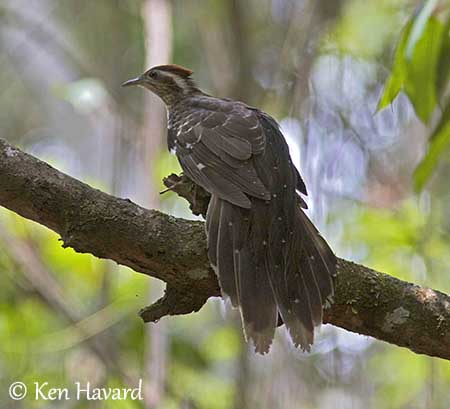
BEHAVIOUR IN THE WILD:
The Pheasant Cuckoo feeds on large insects such as grasshoppers, cicadas and beetles, but it also takes small lizards and nestling birds.
The foraging behaviour of this species involves sounds and feather movements, probably used to flush the preys hidden in the vegetal cover and the leaf litter.
A low rattle is produced by wing and tail feather vibration and bill-clapping. Other fluttering noises are also heard during the distinct phases of the foraging behaviour.
The first phase or “bob” shows the bird on the ground. Its body, wings and tail are bobbing up and down. The tail is fanned and brushes gently the leaf litter.
After a short pause, the second phase or “rush” shows the bird running forwards in several short, quick steps. The head is outstretched and low. The wings, and especially primaries and alula, are extended out and downwards below the body-level, and flick forwards intermittently. Bill-clapping can be heard and the fluttery rattle noise is increasing throughout the “rush”. The bird stops abruptly after 1-2 seconds, ceasing both noise and movement.
The third phase or “peck” shows the foraging bird pecking in the leaf litter, capturing some preys and searching for invertebrates on the ground while walking.
This phase lasts 2-15 seconds or longer, according to the type of prey. Then, the Pheasant Cuckoo starts a new sequence “bob-rush-peck”. It may forage for several hours every day.
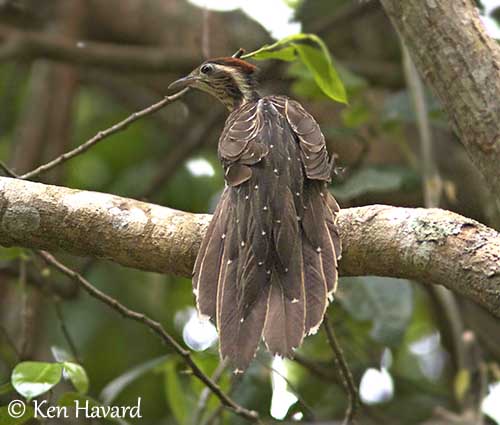
Little is known about the courtship displays of this species, but we can suggest that they are fairly similar to the previous displays, in order to enhance the long, white-tipped wing and tail feathers while the crest is raised. But usually, the pair-bonds are not very strong between the mates.
The Pheasant Cuckoo is a terrestrial species, but it flies well and quickly, and even silently during the territorial displays.
Nothing is known about migrations but this species is probably resident in its range.
REPRODUCTION OF THIS SPECIES:
The breeding season may vary according to the range, but the male sings from March to August in Mexico and from April to July in Panama.
The Pheasant Cuckoo is a brood parasite, and its hosts are typically passerines which make covered, domed nests. This type of nest is that of tyrannid flycatchers of genera Tolmomyias, Myiozetetes, Rhynchocyclus, Fluvicola and Thamnophilus.
The Pheasant Cuckoo female lays a dull white or pale buff egg with some rufous spots in the nest of the chosen host while this one is absent. The host species will provide parental care to egg and chick until the young bird becomes independent.
The young cuckoo probably ejects host’s eggs and/or chicks from the nest.
PROTECTION / THREATS / STATUS:
The Pheasant Cuckoo has wide range, but the species is affected by changes and fragmentation of its habitat. However, it also benefits from new suitable habitat due to degradation of some areas.
With its secretive and solitary behaviour, this species appears uncommon, rare or local. The global population was placed in the band 50,000/499,999 individuals in 2008. It is suspected to be increasing.
But currently, the Pheasant Cuckoo is evaluated as Least Concern.
